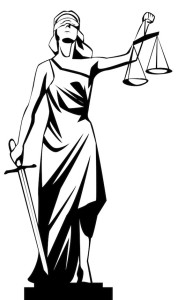I’ve just completed serving on a jury. It was a four-day civil trial. Not at all complicated, in the broad scheme of things, but a very disturbing series of events in the lives of all the parties involved. I couldn’t blog about the trial while it was going on, but now I am allowed to talk about the case.
The facts of the case are as follows.
The defendant was driving south, stopped at a stop sign on an two-lane east-west highway. West-bound traffic on the highway was backed up several blocks from an intersection further to the west. There was little or no east-bound traffic at that moment. The intersection was clear, though cars in the west-bound lane impaired vision of traffic heading east.
The defendant states that the driver to her left gestured that she could proceed through the intersection. She claims that she moved to the center line and stopped again. She then moved into the east-bound lane and was promptly T-boned by an SUV heading east. The defendant stated that she thought the impact was comparable to a time when she was a passenger in a vehicle that had been hit by a car traveling at 65 mph.
The plaintiff in the case stated that she was traveling at a moderate rate of speed when the defendant crossed her lane. She did not see the defendant’s car and was unable to stop.
The plaintiff was suing the defendant for payment of medical bills and emotional damages.
I’ll not bore you with all the details of three days of testimony. Suffice it to say that after listening to doctor after doctor, this juror had only one conclusion: the plaintiff should have been suing the medical profession.
The case had a lot of trivial anomalies that all add up to making it difficult for anyone to get the justice they deserve.
The first issue was that the plaintiff didn’t speak English, though she had been in the country for some time (unfortunately, it was never revealed how long she had been here, how long she had been driving in this country, nor even whether she had a valid driver’s license), so all her court communications had to be handled through an interpreter. While she was receiving medical treatment, all of her interactions with the doctors and practitioners had to be handled by her husband.
The second issue was the initial police report. The patrolman, an experienced member of the police force, had handled hundreds, if not thousands of traffic accidents over his career, yet still the accident report contained errors and had missing information. A second officer drew a diagram of the accident scene, showing where the accident occurred and where the vehicles ended up.
What was interesting about that diagram was that it appeared that both sets of counsel misinterpreted what it said. The vehicles entering the accident scene were identified as Vehicle 1 (heading south) and Vehicle 2 (heading east). After the accident, the vehicles were identified as CD and AB, showing where the front and rear of the vehicles were aligned. It was only when one of the jurors (someone with an eye for trivial detail) asked for clarification that the lawyers were able to determine that the defendant’s vehicle was the one two hundred feet east of the accident and the plaintiff’s vehicle ended up 40 feet southeast of the impact spot. (As one might expect, the officer who drew the diagram had logically identified Vehicle 1 as AB and Vehicle 2 as CD — this just wasn’t made clear on the diagram.)
The third issue was the way we respond to prior problems. Since the plaintiff had been in an accident, she and everyone assumed that all problems she had subsequent to the accident were due to the accident. In fact, once someone proposed that she might have a concussion, that supposition became the driving force in her treatment. In my mind, it was a classic example of everyone trying to do the “right” thing, all the time not really knowing what the right thing really was.
The case was concluded with two insurance companies disputing how much they wanted to pay, yet each incurring major outlays of monies for legal fees, expert testimony, and court time.
Is it no wonder MacFarland thinks we are sometimes too litigious for our own good?
